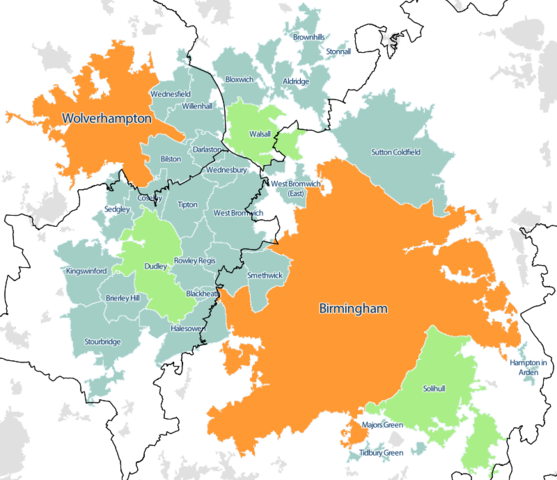Conurbation

|
| The West Midlands Built-Up Area as at the 2011 Census, with overlay of the 2007 Travel to Work Areas. Cities are highlighted in orange, and towns with local authority districts named after them highlighted in green. Source. |
The term ‘conurbation’ refers to: 'A region comprising a number of cities, large towns and other urban areas that, through population growth and physical expansion, have merged to form one continuous urban and industrially developed area.' Ref The HS2 London-West Midlands Environmental Statement, published by the Department for Transport in November 2013.
Spatial development glossary, European Conference of Ministers responsible for Spatial/Regional Planning (CEMAT), Territory and landscape, No. 2, published by Council of Europe Publishing in 2007, states: ‘A conurbation is an aggregation or continuous network of urban communities which have physically merged through population growth and expansion. It is a polycentric form of agglomeration. Physical proximity and continuity of built-up areas are a prerequisite for the definition of a conurbation, which does not exclude that interstitial open spaces may also exist. Conurbations generally developed during the industrial revolution when settlements were built up in areas with significant raw materials (especially mines) or along coastal strips (between the shore line and the mountains in the hinterland).’
[edit] Related articles on Designing Buildings
Featured articles and news
Infrastructure that connect the physical and digital domains.
Harnessing robotics and AI in challenging environments
The key to nuclear decommissioning and fusion engineering.
BSRIA announces Lisa Ashworth as new CEO
Tasked with furthering BSRIA’s impressive growth ambitions.
Public buildings get half a million energy efficiency boost
£557 million to switch to cleaner heating and save on energy.
CIOB launches pre-election manifesto
Outlining potential future policies for the next government.
Grenfell Tower Inquiry announcement
Phase 2 hearings come to a close and the final report due in September.
Progress from Parts L, F and O: A whitepaper, one year on.
A replicated study to understand the opinion of practitioners.
ECA announces new president 2024
Electrical engineer and business leader Stuart Smith.
A distinct type of countryside that should be celebrated.
Should Part O be extended to existing buildings?
EAC brands heatwave adaptation a missed opportunity.
Definition of Statutory in workplace and facilities management
Established by IWFM, BESA, CIBSE and BSRIA.
Tackling the transition from traditional heating systems
59% lack the necessary information and confidence to switch.
The general election and the construction industry
As PM, Rishi Sunak announces July 4 date for an election.
Eco apprenticeships continue help grow green workforce
A year after being recognised at the King's coronation.
Permitted development rights for agricultural buildings
The changes coming into effect as of May 21, 2024.





















